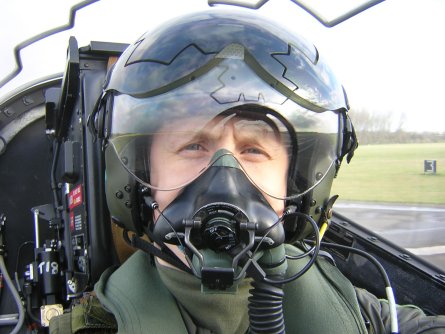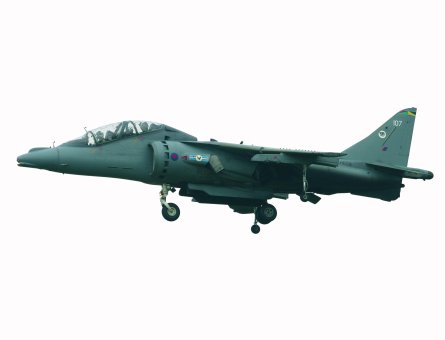Craig Hoyle / RAF Wittering
|
The British-designed Harrier has had to display tremendous versatility since its debut flight in October 1960 as the Hawker Siddeley P.1127 prototype. Intended for use against armoured vehicles in Cold War Europe and later adapted to operate from the Royal Navy’s aircraft carriers, the short take-off and vertical landing type is now being called on to again prove its worth: this time as a close air support (CAS) asset capable of overcoming the formidable environmental challenges of Afghanistan.
Regularly operating as part of a combined air package alongside US Air Force Boeing B-52 bombers, Fairchild A-10 ground-attack aircraft and General Atomics Aeronautical Systems MQ-1 Predator unmanned air vehicles, the UK’s Joint Force Harrier (JFH) is adjusting to life using a single platform type, following the retirement earlier this year of its last British Aerospace Sea Harrier FA2 fighters (Flight International, 28 March–3 April).
New engine
To eventually total four frontline squadrons and an operational conversion unit (OCU), JFH now uses BAe-built and Rolls-Royce Pegasus 105-powered Harrier GR7s, and GR7As equipped with the more powerful Pegasus 107 engine. Introduced across part of the frontline Harrier fleet, the 107 is playing an important role in enabling the GR7A to operate in the hot and high conditions found at Afghanistan’s Kandahar airfield, where daytime temperatures will reach over 40ºC (105ºF) by mid-year. The GR7A is the only fighter currently capable of operating from Kandahar’s deteriorating runway, which is undergoing running repairs. The new engine will also enable embarked aircraft to take off from the RN’s Invincible-class carriers with a stores load comparable to that of a land-based Harrier, and to return to the ship with an increased payload. Under combat conditions, the 107 will also allow the Harrier to reach its desired altitude quicker, improve its turn performance and enable it to land vertically if required.
Pilots from the Royal Air Force’s 1 and 4 Squadrons have been rotating to Kandahar since September 2004 to operate a JFH detachment of six GR7As. This had been scheduled to stand down on 30 June, but the aircraft are now to remain until at least 31 March 2007, following a Ministry of Defence decision to extend the UK’s commitment to providing air support to British troops and the NATO-led International Security Assistance Force (Flight International, 2-8 May). The RN’s newly reformed 800 Naval Air Squadron is to conduct its first tour of duty in Afghanistan with the GR7As from October 2006, although around three navy pilots are now at Kandahar with the RAF’s 1 Sqn.
The high operational tempo of the newly rationalised Harrier force is placing tough demands on JFH’s fleet of aircraft, its current squadron personnel and on the training pipeline. However, Flight International was recently invited to visit the UK’s Harrier OCU – 20 Sqn at RAF Wittering in Cambridgeshire – and given the exclusive opportunity to fly one of the unit’s T10 two-seat trainers.
Reflecting the dual-service nature of the JFH organisation, the RAF’s 20 Sqn has a current strength of eight air force and three navy instructor pilots. They are now responsible for managing the conversion of 11 ab initio students and three experienced RN fighter pilots – among the last to transition from the Sea Harrier to the Harrier GR7/7A. JFH is targeted to eventually have a 50:50 split between RAF and RN personnel, reflecting its eventual structure of two frontline squadrons of aircraft per service, all of which are to be based at nearby RAF Cottesmore in Rutland.
Safety briefing
Call-sign Striker 10, my Harrier T10 flight from Wittering took place on a typical British spring morning, with wind gusting to over 30kt (55km/h). My pilot – a navy Lt Cdr who requested that I identify him only by his nickname, “Tinsel”, gave me my final safety briefing before I was strapped into the rear cockpit of the aircraft (ZH659).
 |
Our flight started with a short take-off run using full flaps, with this intended to replicate a Cold War requirement for the Harrier to operate from improvised strips. The Pegasus 105-powered aircraft’s acceleration was spectacular, and we were airborne in a little over 300m (1,000ft) from brakes off. After completing a steep, banking climb we departed the airfield circuit to the east, descending to low level across the Fens towards March. It was here that I was given my first of two opportunities to fly the T10, with this spell allowing me to check out its ease of operation and handling responsiveness at 250ft and 450kt. Although my previous fast-jet experience had been limited to using simulators, I found the aircraft easy to fly, while its head-up display symbology was simple, uncluttered and easy to use.
After handing back the controls we flew past Rutland Water and continued at low level, before climbing to pass over RAF Coningsby – home to the RAF’s first Eurofighter Typhoons. My pilot then demonstrated the Harrier’s ground-attack capabilities by conducting an aggressive “bombing run” on the airfield at the former RAF Binbrook, reaching our maximum sortie limit of 4g. Despite their reputation as air-to-air specialists, having until recently used the Sea Harrier FA2’s Blue Vixen radar and Raytheon AIM-120 AMRAAM missiles, RN pilots are equally as capable in the CAS environment, and our two simulated 455kg (1,000lb) drag bombs scored direct hits on our intended target building. Used during our attack run, I also found the T10’s rear cockpit displays – such as its moving map and nose-mounted TV sensor – to be well positioned and easy to see.
Following my second stint at the controls – this time at around 400ft – “Tinsel” took us up to medium level, where he demonstrated some of the Harrier’s unique flight control characteristics. These include the type’s ability to use its nozzles to push over the top of a loop at only 60-70kt, before continuing into a braking stop spiral, which limited our descent speed to just 130kt.
As we rejoined the circuit at Wittering towards the end of our 50min sortie, I was able to experience a trio of landing modes available to Harrier pilots. These included a conventional landing at a forward speed of 165kt, a rolling vertical landing while sustaining forward flight at around 50kt – significantly lower than the 90kt needed to recover GR7As in Kandahar during my visit to Afghanistan early last month – and finally landing vertically.
Water supply
Our final manoeuvre was conducted after we performed the Harrier’s air show party trick: the braking hover stop, or bow. With around 2,700kg (6,000lb) of fuel and the aircraft’s entire supply of water – required to enable it to hover – used up, we returned to the flight line before I received a quick debrief.
In an attempt to better meet the combat needs of Afghanistan and other future JFH taskings, 20 Sqn is conducting a review of its training syllabus, including a consideration to whether it could deliver future pilots in a combat-ready state to the RAF’s 1 and 4 Squadrons and the RN’s 800 and 801 Naval Air Squadrons.
Students converting on to the Harrier fleet are faced with an array of aircraft standards, with the GR7/7A and T10 to gradually give way to the upgraded Harrier GR9/9A and T12. The latter designations will be attributed to the 60 single-seat strike aircraft and 10 two-seat trainers set to undergo a BAE Systems-led and largely software-based upgrade, which is introducing an open-architecture mission computer and an expanded range of weapon types.
BAE says it is on track to meet a September in-service date for the GR9, with the entire fleet of upgraded aircraft to be operational by late 2008. Operations of the type are expected to end late next decade, following the introduction into UK service of the Lockheed Martin F-35 Joint Strike Fighter. If the current level of JFH tasking in Afghanistan, combined with the combat commitments of recent years in Iraq and Kosovo are anything to go by, its pilots will not get much rest.
Source: Flight International









































